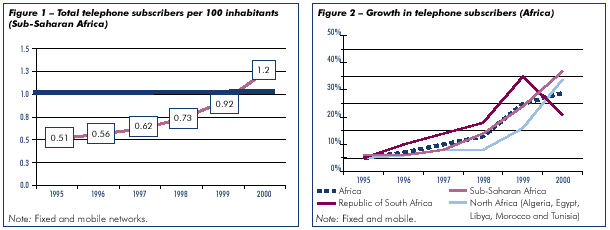
The year 2000 was a year to celebrate in the telecommunication history of the African continent. It will be remembered as the year when Sub-Saharan Africa achieved a telephone density of one subscriber per 100 inhabitants (see Figure 1 and Table 1), an encouraging start to the beginning of the new millennium.
| *Adapted from African Telecommunication Indicators 2001, a key ITU report to be released at ITU TELECOM AFRICA 2001 |
This breakthrough does not come as a surprise for analysts who have been tracking the continent. There has been a noticeable upturn in African economies since the middle of the last decade. Economic growth has averaged 4 per cent a year, and export growth nearly doubled. On the telecommunication front, network growth on a continent-wide basis has increased each year since 1995 (see Figure 2). The growth in telecommunication networks in Africa is logically related to the upswing in the economy. Equally important is that telecommunication liberalization on the continent is finally beginning to bear fruit. Another factor is a marriage seemingly made in heaven for Africa’s citizens: mobile cellular and pre-paid cards.

A striking example of telecommunication liberalization is that, as of the year 2001, a majority (56 per cent) of countries on the continent now allow competition in mobile cellular networks (see Figure 3). This is up from just 7 per cent of African countries with competitive mobile markets in 1995. Another bright spot is that only six African countries are lacking a cellular network in 2001 compared to 28 in 1995. Even in countries where there is only one cellular company, if it is distinct from the fixed-line operator, then there is a degree of competition since users have the option of a fixed or mobile network. Growth in the number of mobile operators on the continent has been astounding. By mid-year 2001, there were some 100 mobile networks in operation up from just 33 in 1995. This is a welcome change from a few years ago when many companies claimed they had licences but never actually launched their networks.
Africa certainly seems to be benefiting from a more liberal mobile market. In many ways, mobile networks are the most appropriate in the African context. They are quick to install and the introduction of prepaid mobile cards is a big advantage for the continent, where incomes are low, and cash upfront is generally the preferred means of payment. Pre-paid access reduces operator risk due to bad credit, and allows many who would not normally qualify for a post-paid service to have a mobile service. Indeed, a growing number of African mobile networks are only pre-paid while, in the continent as a whole, four out of every five subscribers use pre-paid; almost twice the global average (see Figure 4).
Another advantage from growing competition is that it has spurred longer-established mobile operators to upgrade their analogue networks to digital ones.
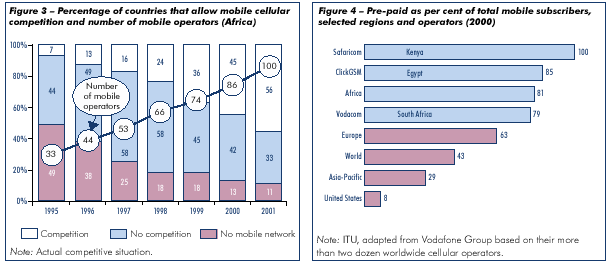
As a result of the explosion of mobile telephony, the number of African countries with more mobile than fixed telephone subscribers is growing. By year-end 2000, 17 countries were in this group (see Figure 5). The rapidity with which this is happening is astounding — in a number of countries, such growth is occurring just one year after the start-up of a new mobile network. It is estimated that sometime in 2001, there will be more mobile than fixed telephone subscribers on the whole African continent (see Figure 6). Incredibly, one forecast estimates almost 100 million mobile users in Africa by 2005, or three times the number of fixed-line subscribers.
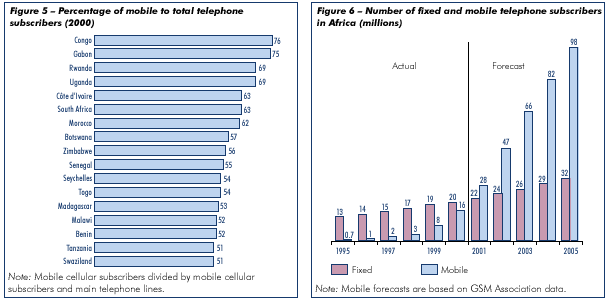
There are a number of lessons to be learned from all this. The first lesson is that countries in the region that have not yet introduced mobile competition are depriving their citizens of increased access to telecommunications. The idea that some markets may be too small for more than one operator is also a myth. Economies with the highest mobile penetration in the region happen to be the smallest in terms of population — Réunion and Seychelles. Yet, despite their small markets, they both found room to accommodate two mobile operators. Réunion set a record in 2001 by becoming the first economy in the region to achieve a mobile penetration of over 50 per cent. Its 357 410 mobile subscribers (at 30 June 2001) make it the fifth largest mobile market in Africa.
A second lesson is that, with a few exceptions, it is not State-owned incumbents, multilateral donors and large multinationals that are building Africa’s telecommunication networks. Rather, a new breed of pan-African mobile companies is creating the mobile miracle in Africa. These pioneers — such as Mobile Telephone Networks (MTN), Orascom Telecom, and MSI — are stringing together regional networks shattering the conventional wisdom that the problem with Africa is a lack of investment. Indeed at the rate things are going, the problem in Africa will no longer be lack of infrastructure, as most of the region’s inhabitants will be covered by a mobile signal. The challenges then become affordability and how the investment in wireless networks can be leveraged to provide access to the Internet.
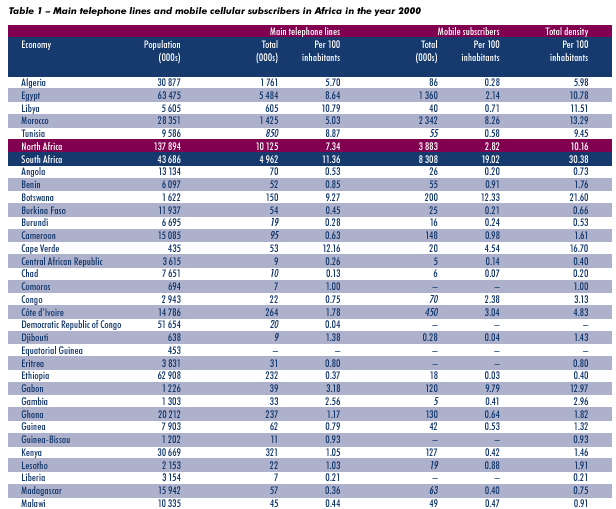
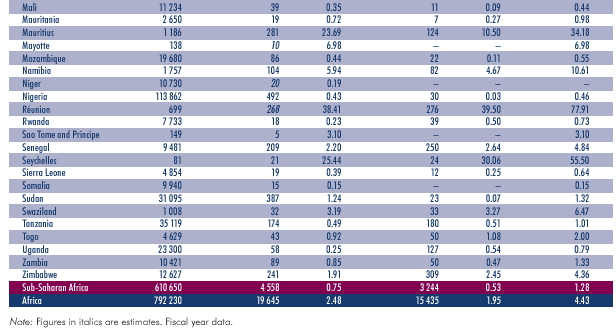
The Republic of South Africa is located at the southern tip of the African continent. Its population was estimated at 44.5 million in July 2001, of which just over half (53 per cent) is urban. It is a multi-ethnic country with a variety of races, languages and cultures.
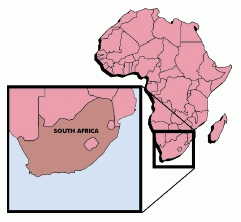
The most significant events in South Africa’s recent telecommunication history were the privatization of Telkom — the incumbent telecommunication operator — and the licensing of two digital GSM networks, followed recently by a third. In April 1997, 30 per cent of Telkom was sold to the Thintana consortium consisting of strategic investors SBC of the United States and Telkom Malaysia. The price of USD 1.3 billion was the highest ever for a privatization in Sub-Saharan Africa. Telkom achieved a number of targets it was assigned in areas such as main line roll-out and public payphone installation. However, around half a million lines were disconnected in 2000 due to non-paying customers and fraud. Telkom’s exclusive basic voice telephony licence expires in May 2002.
Two cellular networks were launched in June 1994. One licence was awarded to Vodacom, backed by a consortium consisting of the incumbent (Telkom), Vodafone of the United Kingdom and others. The second was awarded to MTN. The networks grew rapidly and by the year 2000, there were more mobile than fixed telephone subscribers in South Africa. Today, the country’s cellular network is the 16th largest in the world, the fourth largest among developing countries and the largest in Africa. South Africa’s mobile success has been marred by a controversy over the award of a third mobile licence. The award has been disputed for the last year, depriving consumers the benefit of yet additional competition in the market. Nonetheless, the winner, Cell C plans to launch its network before year-end 2001.
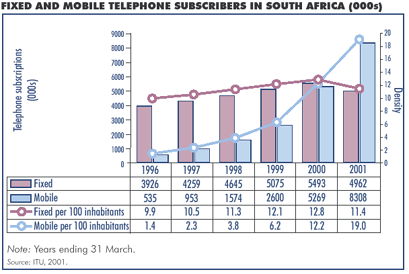
Responsibility for telecommunication policy-making rests with the Ministry of Communications. The Telecommunications
Act of 1996 led to the establishment of the South African Telecommunication Regulatory Authority (SATRA). In 2000, it
was combined with the Independent Broadcasting Authority to form one of the first "converged" regulators in
the world, the Independent Communications Authority of South Africa. However, the convergence is more institutional than
real since the country has been slow to adopt broadband technology. This is a surprise since South Africa is, by far,
the largest Internet market in Africa with an estimated 1.5 million people (3.4 per cent of the population) having
access to the Internet from their home in June 2001 (Source: Nielsen // NetRatings).
More information on broadband in South Africa is available at www.itu.int/osg/spu/ni/broadband/workshop/southafricafinal.pdf.
One area to which South Africa has devoted a lot of attention is universal telecommunication service/access. A Universal Service Agency was created to assist the spread of telecommunication throughout the nation. In addition, Statistics South Africa has been at the forefront of measuring telephone access in its annual household surveys. In 2000, it was estimated that 42 per cent of South Africans had universal service (a telephone in their home) while 80 per cent had universal access (within 30 minutes of a telephone). In the next survey, a more rigorous definition of being within 15 minutes of a telephone will be used.
| For more information or comments on the UPDATE, please contact:
ITU/BDT, Telecommunication Data and Statistics, |